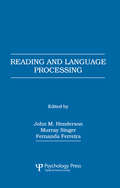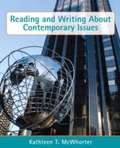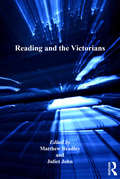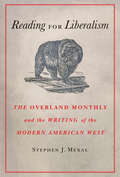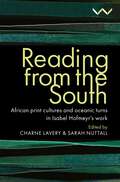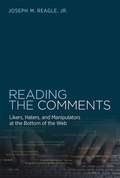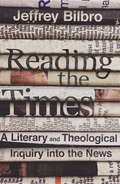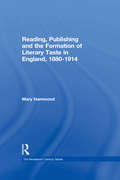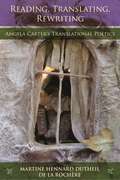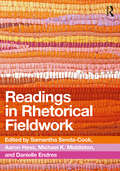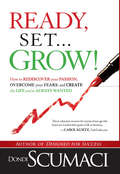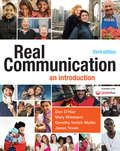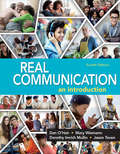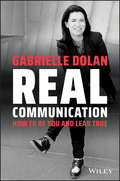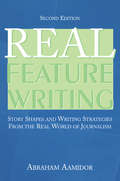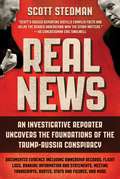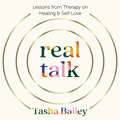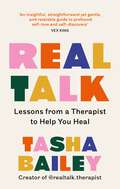- Table View
- List View
Reading and Language Processing
by Fernanda Ferreira Murray Singer John M. HendersonThis volume was designed to identify the current limits of progress in the psychology of reading and language processing in an information processing framework. Leaders in their fields of interest, the chapter authors couple current theoretical analyses with new, formally presented experiments. The research -- cutting-edge and sometimes controversial -- reflects the prevailing analysis that language comprehension results in numerous levels of representation, including surface features, lexical properties, linguistic structures, and idea networks underlying a message as well as the situations to which a message refers. As a group, the chapters highlight the impact that input modality -- auditory or written -- has on comprehension. Finally, the studies also capture the evolution of new topic matter and ongoing debates concerning the competing paradigms, global proposals, and methods that form the foundation of the enterprise. The book presents current accounts of research on word-, sentence-, and text-processing. It will prove informative for experimental psychologists as well as investigators in cognitive science disciplines such as computer science, linguistics, and educational psychology. The book will also be very helpful to graduate students who wish to develop expertise in the psychology of language processes. For them, it collects, in a single volume, readings that are representative of progress concerning many central problems in the field. As such, it is distinct from the numerous collected volumes that concentrate on a single issue. Complete author and subject indexes facilitate effective use of the volume.
Reading and Writing About Contemporary Issues
by Kathleen T. McwhorterReading and Writing About Contemporary Issues offers an integrated approach to reading and writing using a handbook for reference and instruction followed by readings for analysis and writing.
Reading and Writing for Civic Literacy: The Critical Citizen's Guide to Argumentative Rhetoric, Brief Edition (Cultural Politics and the Promise of Democracy)
by Donald Lazere Anne-Marie WomackThis rhetoric-and-reader textbook teaches college students to develop critical reading, writing, and thinking skills for self-defense in the contentious arena of American civic rhetoric. This edition is substantially updated for an era of renewed tensions over race, gender, and economic inequality—all compounded by the escalating decibel level and polarization of public rhetoric. Readings include civil rights advocate Michelle Alexander on "the new Jim Crow," recent reconsiderations of socialism versus capitalism, Naomi Wolf’s and Christine Hoff Sommers’ opposing views on "the beauty myth," a section on the rhetoric of war, and debates on identity politics, abortion, and student debt. Designed for first-year or more advanced composition and critical thinking courses, the book trains students in a wealth of techniques to locate fallacies and other weaknesses in argumentation in their prose and the writings of others. Exercises also help students understand the ideological positions and rhetorical patterns that underlie opposing views, from Ann Coulter to Bernie Sanders. Widely debated issues of whether objectivity is possible and whether there is a liberal or conservative bias in news and entertainment media, as well as in education itself, are foregrounded as topics for rhetorical analysis.
Reading and the Victorians (The Nineteenth Century Series)
by Juliet JohnWhat did reading mean to the Victorians? This question is the key point of departure for Reading and the Victorians, an examination of the era when reading underwent a swifter and more radical transformation than at any other moment in history. With book production handed over to the machines and mass education boosting literacy to unprecedented levels, the norms of modern reading were being established. Essays examine the impact of tallow candles on Victorian reading, the reading practices encouraged by Mudie's Select Library and feminist periodicals, the relationship between author and reader as reflected in manuscript revisions and corrections, the experience of reading women's diaries, models of literacy in Our Mutual Friend, the implications of reading marks in Victorian texts, how computer technology has assisted the study of nineteenth-century reading practices, how Gladstone read his personal library, and what contemporary non-academic readers might owe to Victorian ideals of reading and community. Reading forms a genuine meeting place for historians, literary scholars, theorists, librarians, and historians of the book, and this diverse collection examines nineteenth-century reading in all its personal, historical, literary, and material contexts, while also asking fundamental questions about how we read the Victorians' reading in the present day.
Reading for Liberalism: The Overland Monthly and the Writing of the Modern American West
by Stephen J. MexalFounded in 1868, the Overland Monthly was a San Francisco–based literary magazine whose mix of humor, pathos, and romantic nostalgia for a lost frontier was an immediate sensation on the East Coast. Due in part to a regional desire to attract settlers and financial investment, the essays and short fiction published in the Overland Monthly often portrayed the American West as a civilized evolution of, and not a savage regression from, eastern bourgeois modernity and democracy.Stories about the American West have for centuries been integral to the way we imagine freedom, the individual, and the possibility for alternate political realities. Reading for Liberalism examines the shifting literary and narrative construction of liberal selfhood in California in the late nineteenth century through case studies of a number of western American writers who wrote for the Overland Monthly, including Noah Brooks, Ina Coolbrith, Bret Harte, Jack London, John Muir, and Frank Norris, among others. Reading for Liberalism argues that Harte, the magazine&’s founding editor, and the other members of the Overland group critiqued and reimagined the often invisible fabric of American freedom. Reading for Liberalism uncovers and examines in the text of the Overland Monthly the relationship between wilderness, literature, race, and the production of individual freedom in late nineteenth-century California.
Reading from the South: African print cultures and oceanic turns in Isabel Hofmeyr’s work
by Sunil Amrith Sarah Nuttall Gabeba Baderoon Pumla Dineo Gqola Khwezi Mkhize James Ogude Christopher EW Ouma Carolyn Hamilton Charne Lavery Karin Barber Rimli Bhattacharya Antoinette Burton Danai S Mupotsa Ranka Primorac Madhumita Lahiri Meg Samuelson Lakshmi SubramanianThis set of essays analyses the work of Isabel Hofmeyr, globally recognised as one of South Africa’s foremost literary and Indian Ocean scholars. The essays elucidate Hofmeyr’s path-breaking studies of transnational histories of the book, African print cultures, and cultural circulations in the Indian Ocean world.This book draws together reflective and analytical essays by renowned intellectuals from around the world who critically engage with the work of one of the global South’s leading scholars of African print cultures and the oceanic humanities. Isabel Hofmeyr’s scholarship spans more than four decades, and its sustained and long-term influence on her discipline and beyond is formidable.While much of the history of print cultures has been written primarily from the North, Isabel Hofmeyr is one of the leading thinkers producing new knowledge in this area from Africa, the Indian Ocean world and the global South. Her major contribution encompasses the history of the book as well as shorter textual forms and abridged iterations of canonical works such as John Bunyan’s The Pilgrim’s Progress. She has done pioneering research on the ways in which such printed matter moves across the globe, focusing on intra-African trajectories and circulations as well as movements across land and sea, port and shore. The essays gathered here are written in a blend of intellectual and personal modes, and mostly by scholars of Indian and African descent. Via their engagement with Hofmeyr’s path-breaking work, the essays in turn elaborate and contribute to studies of print culture as well as critical oceanic studies, consolidating their findings from the point of view of global South historical contexts and textual practices.
Reading the Comments
by Joseph M. ReagleOnline comment can be informative or misleading, entertaining or maddening. Haters and manipulators often seem to monopolize the conversation. Some comments are off-topic, or even topic-less. In this book, Joseph Reagle urges us to read the comments. Conversations "on the bottom half of the Internet," he argues, can tell us much about human nature and social behavior.Reagle visits communities of Amazon reviewers, fan fiction authors, online learners, scammers, freethinkers, and mean kids. He shows how comment can inform us (through reviews), improve us (through feedback), manipulate us (through fakery), alienate us (through hate), shape us (through social comparison), and perplex us. He finds pre-Internet historical antecedents of online comment in Michelin stars, professional criticism, and the wisdom of crowds. He discusses the techniques of online fakery (distinguishing makers, fakers, and takers), describes the emotional work of receiving and giving feedback, and examines the culture of trolls and haters, bullying, and misogyny. He considers the way comment -- a nonstop stream of social quantification and ranking -- affects our self-esteem and well-being. And he examines how comment is puzzling -- short and asynchronous, these messages can be slap-dash, confusing, amusing, revealing, and weird, shedding context in their passage through the Internet, prompting readers to comment in turn, "WTF?!?"
Reading the Comments: Likers, Haters, and Manipulators at the Bottom of the Web (The\mit Press Ser.)
by Joseph M. ReagleWhat we can learn about human nature from the informative, manipulative, confusing, and amusing messages at the bottom of the web.Online comment can be informative or misleading, entertaining or maddening. Haters and manipulators often seem to monopolize the conversation. Some comments are off-topic, or even topic-less. In this book, Joseph Reagle urges us to read the comments. Conversations “on the bottom half of the Internet,” he argues, can tell us much about human nature and social behavior.Reagle visits communities of Amazon reviewers, fan fiction authors, online learners, scammers, freethinkers, and mean kids. He shows how comment can inform us (through reviews), improve us (through feedback), manipulate us (through fakery), alienate us (through hate), shape us (through social comparison), and perplex us. He finds pre-Internet historical antecedents of online comment in Michelin stars, professional criticism, and the wisdom of crowds. He discusses the techniques of online fakery (distinguishing makers, fakers, and takers), describes the emotional work of receiving and giving feedback, and examines the culture of trolls and haters, bullying, and misogyny. He considers the way comment—a nonstop stream of social quantification and ranking—affects our self-esteem and well-being. And he examines how comment is puzzling—short and asynchronous, these messages can be slap-dash, confusing, amusing, revealing, and weird, shedding context in their passage through the Internet, prompting readers to comment in turn, “WTF?!?”
Reading the Times: A Literary and Theological Inquiry into the News
by Jeffrey Bilbro"Reading the morning newspaper is the realist's morning prayer."—G. W. F. Hegel Whenever we reach for our phones or scan a newspaper to get "caught up," we are being not merely informed but also formed. News consumption can shape our sense of belonging, how we judge the value of our lives, and even how our brains function. Christians mustn't let the news replace prayer as Hegel envisioned, but neither should we simply discard the daily feed. We need a better understanding of what the news is for and how to read it well. Jeffrey Bilbro invites readers to take a step back and gain some theological and historical perspective on the nature and very purpose of news. In Reading the Times he reflects on how we pay attention, how we discern the nature of time and history, and how we form communities through what we read and discuss. Drawing on writers from Thoreau and Dante to Merton and Berry, along with activist-journalists such as Frederick Douglass and Dorothy Day, Bilbro offers an alternative vision of the rhythms of life, one in which we understand our times in light of what is timeless. Throughout, he suggests practices to counteract common maladies tied to media consumption in order to cultivate healthier ways of reading and being. When the news sets itself up as the light of the world, it usurps the role of the living Word. But when it helps us attend together to the work of Christ—down through history and within our daily contexts—it can play a vital part in enabling us to love our neighbors. Reading the Times is a refreshing and humane call to put the news in its place.
Reading, Publishing and the Formation of Literary Taste in England, 1880-1914 (The Nineteenth Century Series)
by Mary HammondBetween 1880 and 1914, England saw the emergence of an unprecedented range of new literary forms from Modernism to the popular thriller. Not coincidentally, this period also marked the first overt references to an art/market divide through which books took on new significance as markers of taste and class. Though this division has received considerable attention relative to the narrative structures of the period's texts, little attention has been paid to the institutions and ideologies that largely determined a text's accessibility and circulated format and thus its mode of address to specific readerships. Hammond addresses this gap in scholarship, asking the following key questions: How did publishing and distribution practices influence reader choice? Who decided whether or not a book was a 'classic'? In a patriarchal, class-bound literary field, how were the symbolic positions of 'author' and 'reader' affected by the increasing numbers of women who not only bought and borrowed, but also wrote novels? Using hitherto unexamined archive material and focussing in detail on the working practices of publishers and distributors such as Oxford University Press and W.H. Smith and Sons, Hammond combines the methodologies of sociology, literary studies and book history to make an original and important contribution to our understanding of the cultural dynamics and rhetorics of the fin-de-siècle literary field in England.
Reading, Translating, Rewriting: Angela Carter's Translational Poetics
by Martine Hennard Dutheil de la RochèreIn translating Charles Perrault's seventeenth-century Histoires ou contes du temps passé, avec des Moralités into English, Angela Carter worked to modernize the language and message of the tales before rewriting many of them for her own famous collection of fairy tales for adults, The Bloody Chamber, published two years later. In Reading, Translating, Rewriting: Angela Carter's Translational Poetics, author Martine Hennard Dutheil de la Rochère delves into Carter's The Fairy Tales of Charles Perrault (1977) to illustrate that this translation project had a significant impact on Carter's own writing practice. Hennard combines close analyses of both texts with an attention to Carter's active role in the translation and composition process to explore this previously unstudied aspect of Carter's work. She further uncovers the role of female fairy-tale writers and folktales associated with the Grimms' Kinder- und Hausmärchen in the rewriting process, unlocking new doors to The Bloody Chamber. Hennard begins by considering the editorial evolution of The Fairy Tales of Charles Perrault from 1977 to the present day, as Perrault's tales have been rediscovered and repurposed. In the chapters that follow, she examines specific linkages between Carter's Perrault translation and The Bloody Chamber, including targeted analysis of the stories of Red Riding Hood, Bluebeard, Puss-in-Boots, Beauty and the Beast, Sleeping Beauty, and Cinderella. Hennard demonstrates how, even before The Bloody Chamber, Carter intervened in the fairy-tale debate of the late 1970s by reclaiming Perrault for feminist readers when she discovered that the morals of his worldly tales lent themselves to her own materialist and feminist goals. Hennard argues that The Bloody Chamber can therefore be seen as the continuation of and counterpoint to The Fairy Tales of Charles Perrault, as it explores the potential of the familiar stories for alternative retellings. While the critical consensus reads into Carter an imperative to subvert classic fairy tales, the book shows that Carter valued in Perrault a practical educator as well as a proto-folklorist and went on to respond to more hidden aspects of his texts in her rewritings.
Readings in Rhetorical Fieldwork
by Samantha Senda-Cook Aaron Hess Michael Middleton Danielle EndresReadings in Rhetorical Fieldwork compiles foundational articles highlighting the development of fieldwork in rhetorical criticism. Presenting a wide variety of approaches, the volume begins with a section establishing the starting points for the development of fieldwork in rhetorical criticism and then examines five topics: Space & Place; Public Memory; Publics and Counterpublics; Advocacy and Activism; and Science, Technology, and Medicine. Within these sections, readers evaluate a full spectrum of methods, from interviews, to oral histories, to participant observation. This volume is invaluable for advanced undergraduate and graduate students of rhetorical criticism, rhetorical fieldwork, and qualitative methods looking for a comprehensive overview of the development of rhetorical fieldwork.
Ready, Set, Grow: How to Rediscover Your Passion, Overcome Your Fears, and Create the Life You've Always Wanted
by Dondi ScumaciSay good-bye to “just getting by” and rediscover a life that you love Is there a dream in you somewhere, buried deep perhaps, that just won’t die? A goal that you’ve pushed aside to deal with the duties, responsibilities, and distractions of your everyday life? Whether you have a poet, an artist, or an accountant inside of you waiting to break out, Dondi Scumaci wants you to know that it isn’t too late! If you have lost your dream, never learned how to dream, or just want to learn how to make your dream a reality, then Ready, Set…Grow! is for you. You will be encouraged to… Identify and overcome self-limiting beliefs, attitudes, and behaviors Live in a state of anticipation, not anxiety Cultivate optimism, even in the most difficult circumstances Live the success you were designed for, and more!
Readymade CVs
by Lynn WilliamsThis best-selling guide sets out the ground rules for preparing a CV by showing how to select which details go in and which stay out, how to lay out and present a CV and how to make a great first impression. It includes sample CVs for a wide variety of jobs: practical, creative, administrative, sales and marketing, technical and management, with online template CVs and covering letters ready for you to download and customise. Readymade CVs also looks at specific 'tricky' situations such as getting your first job, returning to work after a career break, continuing in work as a mature employee or after retirement. With the addition of action words and positive phrases to help you put together the perfect CV for any job or situation, this is a truly comprehensive and indispensable resource.
Real Communication
by Dan O’hair Mary Wiemann Dorothy Imrich Mullin Jason TevenReal Communication uses stories from real people and the world around us as the foundation for the liveliest introduction to human communication available today. Professors and students alike have fallen in love with Real Communication's down-to-earth writing style, its current scholarship, and its wealth of learning and teaching tools. They also appreciate how Real Communication strives to weave together the discipline's different strands with CONNECT, a feature that shows students how to apply concepts across interpersonal, small group, and public speaking contexts.
Real Communication
by Dan O’hair Mary Wiemann Dorothy Imrich Mullin Jason TevenReal Communication uses the liveliest stories from real people and the world around us as the foundation for teaching the theory and skills of human communication available today. Professors and students alike have fallen in love with the authors'down-to-earth writing style and commitment to providing the most current scholarship that reflects the world we live in, from the challenges that arise with pervasive digital media to new ways for understanding listening goals. They also appreciate how Real Communication weaves together the discipline's different strands with "Connect," a feature that shows students how to apply concepts across interpersonal, small group, and public speaking contexts.
Real Communication: An Introduction (Budget Bks.)
by Dan O'Hair Mary Wiemann Jason Teven Dorothy MullinReal Communication continues to prove its reputation as the most current human communication text available. This new edition provides today’s students with the critical skills they now need most: to be able to objectively encounter increasingly digital communication contexts, examine the theory and concepts underpinning them, and competently respond in a professional, healthy, and intentional way. Utilizing a social-scientific approach to communication, the text uses engaging stories which work as small case studies that students learn to see and analyze as communication situations, discovering theory played out in practice. Authored by a leading team of communication scholars and instructors, this authoritative text helps students become social scientists in communication to confront and adapt to the challenges of today’s digital age.
Real Communication: How To Be You and Lead True
by Gabrielle DolanEffective communication through authentic leadership A rapidly evolving workplace and disruptive technologies have created a growing demand for transparency and authenticity in communication from business leaders. Yet many decision-makers find themselves far behind the curve when it comes to understanding and meeting the evolving expectations of employees and customers. Real Communication: How to Be You and Lead True reveals how to guide and communicate in a way that is authentic and will help business leaders truly connect and engage with their teams, customers, and coworkers. • Communicate more effectively • Improve employee engagement • Manage organisational changes • Help teams cope with change When employees trust their leaders, businesses thrive. In Real Communication you will find everything you need to implement new strategies, instill core values, and cultivate engagement.
Real Feature Writing (Routledge Communication Ser.)
by Abraham AamidorReal Feature Writing emphasizes story shape and structure by illustrating several distinct types of feature and non-fiction stories, all drawn from the real world. Author Abraham Aamidor presents a collection of distinct non-deadline story types (profile, trend, focus, advocacy, and more), providing an introduction to each story type, a full-text example, a critical analysis of the example, and clear directions for producing similar stories. In this second edition, Aamidor and his guest contributors (all with real-world journalistic experience) demonstrate in clear, honest language how to write features. New for this edition are:*updated examples of feature writing, integrated throughout the text;*a chapter on ethical journalism, which takes a critical look at propaganda;*a chapter on international perspectives, including coverage of issues in the Middle East;*chapters on research, freelancing, content editing, copyediting, and literary journalism.This text is appropriate for upper-level journalism students, and will be a valuable resource for freelance writers and young working journalists needing guidance on writing features.
Real Friends Talk About Race: Bridging the Gaps Through Uncomfortable Conversations
by Yseult P. Mukantabana Hannah SummerhillReal Friends Talk About Race is an essential guide for those who want to have stronger interracial relationships—whether it&’s with friends, colleagues, or loved ones. Having conversations about race is uncomfortable. But for progress between individuals (and our communities) to happen, we need to be able to speak openly and honestly. Podcast hosts of The Kinswomen Yseult and Hannah use their own friendship and experiences from different racial backgrounds to offer guidance on navigating these layered conversations. In Real Friends Talk About Race, the duo share their two perspectives on the ways in which culture, history, and white supremacy have prevented us from having the skills to build trust and healthy relationships across race. Yseult and Hannah approach these topics with love and candor—calling readers in (not out) to confront hard realities and their own internalized biases, while also sharing prescriptive advice, encouragement, and a sense of community.Real Friends Talk About Race is a must-read for anyone looking to listen, learn, and feel empowered to have meaningful conversations about race.
Real Leaders Negotiate!
by Jeswald W. SalacuseThis book examines the central role of negotiation in gaining, exercising, and retaining leadership within organizations, large and small, public and private. Its aim is to instruct readers on the way to use negotiation to lead effectively. For far too long conventional wisdom has proposed that strong leaders refuse to negotiate, viewing negotiation as a sign of weakness. Leading people requires charisma, vision, and a commanding presence, not the tricks for making deals. For many executives, negotiation is a tool to use outside the organization to deal with customers, suppliers, and creditors. Inside the organization, it's strictly "my way or the highway. " Salacuse explains that leaders can increase their effectiveness by using negotiation in each of the three phases of the leadership lifecycle: 1) leadership attainment, 2) leadership action; and 3) leadership preservation and loss. Drawing on experience in wide variety of settings, including the author's own leadership positions, the book will examine high profile leadership cases such as the rise and fall of Carly Fiorina at Hewlett-Packard, the skillful negotiations by Warren Buffet to save Salomon Brothers from extinction, and the successful efforts by the partners at Goldman Sachs to negotiate a new vision and direction for that financial giant. Leaders and managers should pick up this book to learn how effective negotiation is essential to both gaining and exercising leadership and to overcoming threats to a leader's position.
Real News: An Investigative Reporter Uncovers the Foundations of the Trump-Russia Conspiracy
by Scott StedmanDocumented Evidence of the Trump-Russia Conspiracy Investigative reporter Scott Stedman has made waves worldwide with his hard-hitting investigative journalism, going as far as anyone has to uncover the deep roots of the Trump-Russia Conspiracy. His research has been cited by the Washington Post, BBC, Reuters, CNN, McClatchy, the Daily Mail, the Guardian, and Vice, and has even helped guide Congress’s investigations.Real News collects, for the first time in print, Stedman’s eye-opening research into and evidence of every level of the Trump-Russia Conspiracy, from the 2016 Trump Tower Meetings to the dirty-money deal for Trump Tower Moscow, from the “coffee boy” George Papadopoulos and his mysterious wife to Russian infiltration of the National Rifle Association, from Cambridge Analytica’s sketchy business deals and influence operations to the battle for true journalism that will combat cries of “Fake News!” Full of real, exclusive evidence including ownership records, flight logs, banking information and statements, meeting transcripts, maps, quotes, stats and figures, cease and desist letters, and more, Real News not only enables readers to see and evaluate the arguments for the existence of the Trump-Russia Conspiracy for themselves, it also fully explains how Stedman went about his investigations to discover the truth. Anyone who is interested in the evidence—the real news about the Trump-Russia Conspiracy—needs to read this book.
Real Talk: Lessons From Therapy on Healing & Self-Love
by Tasha BaileyIt's time to bring therapy out of the therapy room and into the real world.In recent years, therapy and self-care have become familiar buzzwords, but it's clear that people are having to face their emotional difficulties without the tools and insight to work through them. Enter Real Talk: A book to enable readers to have genuine, authentic conversations with themselves, and to start the journey of healing their past experiences and cope with the challenges of modern life.Filled with techniques and wisdom from a therapist's toolkit this is a must-have handbook for optimising your mental health. Drawing on her experience as a qualified psychotherapist and applying her intersectional perspective Tasha Bailey shares the knowledge and skills you need to change your life.Tasha's straight-talking but compassionate style will help readers hold up a mirror to their present situation and make sense of their past - delving into topics such as:· Trauma & inner-child healing· Love, trust, and attachment· Family: intergenerational cycles of behaviour, rupture, and repair.· Self-Esteem, bodies & sexReal Talk contains a collection of lessons which the reader might typically learn in therapy. Tasha teaches readers modern language and ideas about mental health, exploring self-love and self-understanding. Connecting psychological theory, lived experience, references from modern day media and case studies from Tasha's work to create a more current, creative, and inclusive perspective of mental health.(p) 2023 Octopus Publishing Group
Real Talk: Lessons From Therapy on Healing & Self-Love
by Tasha Bailey'Real Talk is like having a kind, supportive and wise one-to-one with a great therapist.' - Abby RawlinsonIt's time to bring therapy out of the therapy room and into the real world.In recent years, therapy and self-care have become familiar buzzwords, but it's clear that people are having to face their emotional difficulties without the tools and insight to work through them. Enter Real Talk: A book to enable readers to have genuine, authentic conversations with themselves, and to start the journey of healing their past experiences and cope with the challenges of modern life.Filled with techniques and wisdom from a therapist's toolkit this is a must-have handbook for optimising your mental health. Drawing on her experience as a qualified psychotherapist and applying her intersectional perspective Tasha Bailey shares the knowledge and skills you need to change your life.Tasha's straight-talking but compassionate style will help readers hold up a mirror to their present situation and make sense of their past - delving into topics such as:· Trauma & inner-child healing· Love, trust, and attachment· Family: intergenerational cycles of behaviour, rupture, and repair.· Self-Esteem, bodies & sexReal Talk contains a collection of lessons which the reader might typically learn in therapy. Tasha teaches readers modern language and ideas about mental health, exploring self-love and self-understanding. Connecting psychological theory, lived experience, references from modern day media and case studies from Tasha's work to create a more current, creative, and inclusive perspective of mental health.
Real Talk: Lessons From Therapy on Healing & Self-Love
by Tasha Bailey'Real Talk is like having a kind, supportive and wise one-to-one with a great therapist.' - Abby RawlinsonIt's time to bring therapy out of the therapy room and into the real world.In recent years, therapy and self-care have become familiar buzzwords, but it's clear that people are having to face their emotional difficulties without the tools and insight to work through them. Enter Real Talk: A book to enable readers to have genuine, authentic conversations with themselves, and to start the journey of healing their past experiences and cope with the challenges of modern life.Filled with techniques and wisdom from a therapist's toolkit this is a must-have handbook for optimising your mental health. Drawing on her experience as a qualified psychotherapist and applying her intersectional perspective Tasha Bailey shares the knowledge and skills you need to change your life.Tasha's straight-talking but compassionate style will help readers hold up a mirror to their present situation and make sense of their past - delving into topics such as:· Trauma & inner-child healing· Love, trust, and attachment· Family: intergenerational cycles of behaviour, rupture, and repair.· Self-Esteem, bodies & sexReal Talk contains a collection of lessons which the reader might typically learn in therapy. Tasha teaches readers modern language and ideas about mental health, exploring self-love and self-understanding. Connecting psychological theory, lived experience, references from modern day media and case studies from Tasha's work to create a more current, creative, and inclusive perspective of mental health.
